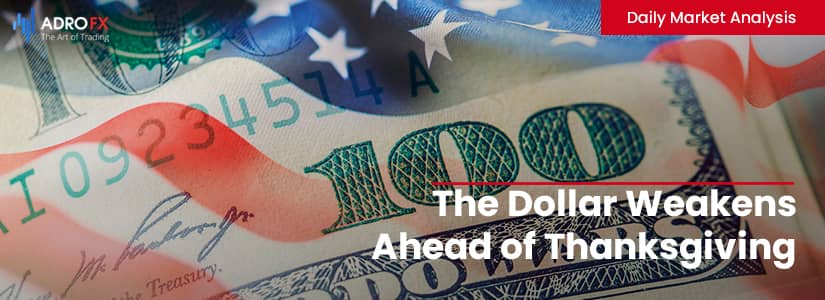The Dollar Weakens Ahead of Thanksgiving | Daily Market Analysis

Key events:
- UK – Composite PMI
- UK – Manufacturing PMI
- UK – Services PMI
- USA – Building Permits
- USA – Core Durable Goods Orders (MoM) (Oct)
- USA – Initial Jobless Claims
- USA – New Home Sales (Oct)
- USA – Crude Oil Inventories
- USA – FOMC Meeting Minutes
The dollar fell in price against all currencies of the Big Ten on Tuesday. It was pressured by a decline in Treasury yields amid renewed demand for risky assets, as evidenced by a rise in equities in both Europe and the U.S. Since the macroeconomic calendar of the first days of the current week (short due to the Thanksgiving holiday in the USA) was not abundant with important statistics, the investors concentrated their attention on the comments of the Fed officials.

The head of the Federal Reserve Bank of Cleveland, Loretta Mester, made it clear that she sees no problem to slow down the rate hike in December. In her view, labor demand is balanced with supply, and there is no sign of an inflationary spiral between wages and price pressures. Meanwhile, the market also paid attention to comments by Robert Holtzman, governor of the Austrian Central Bank, who said he supports a third consecutive ECB rate hike of 75 bps at the next meeting. The swap market has now priced in only a 60bp increase.
The dollar was also weaker against most G10 currencies on the morning of Wednesday, November 23. The New Zealand dollar was the biggest gainer.

The Reserve Bank of New Zealand raised its key rate by 75 bps to 4.25%, as expected, saying rates would peak at 5.5% rather than the 4.1% level that had been in previous forecasts. At the same time, the regulator predicts a recession in the economy in 2023.
Preliminary data on durable goods orders for October, unemployment benefits, and November business activity in the manufacturing and services sectors (PMI) will be released today, as calculated by S&P Global. New home sales in October will complete the statistical package.
The Durable Goods Orders data may reflect steady demand, and it will not be the argument for a soft landing of the economy that the market had hoped for. It is likely that the data will signal that the U.S. economy is rather in the overheated territory, which means the Fed needs to do more to get inflation under control.
In that vein, the release of the Nov. 2 FOMC meeting minutes will be important for investors. The minutes might give a more detailed picture of how many Open Market Committee members share the view that the Fed has made significant progress in controlling inflation, and how many still think there are no significant signs that inflation can be controlled.
Still, some of the dollar's uncertainty in trying to resume gains this week stems from the fact that historically the week, when Thanksgiving is celebrated, is a positive one for the stock market. Thanksgiving is what we think is pushing the dollar in the short term. The U.S. currency is not feeling support from the demand for safe-haven assets right now.
And that would make sense, as China may return to tight quarantines amid the pandemic situation in the country, raising the risks of a global recession. The 2-10 year spread (the yield curve for treasuries) reached a record low of -76 bps. This is also a factor in favor of risk-off demand, but the dollar has not returned to a solid recovery from the November collapse.
The Fed wants to get the market to stop looking in the data for a signal that rates could be raised again in December by 75 bps. The Fed wants to break those expectations. That said, the U.S. Central Bank is clearly hinting that the rate hike cycle will be longer. Under those conditions, we believe the dollar will test the upper bound of the 106-110 point range over the next few weeks. However, our medium-term range for the dollar index is between 107 and 112 points.










